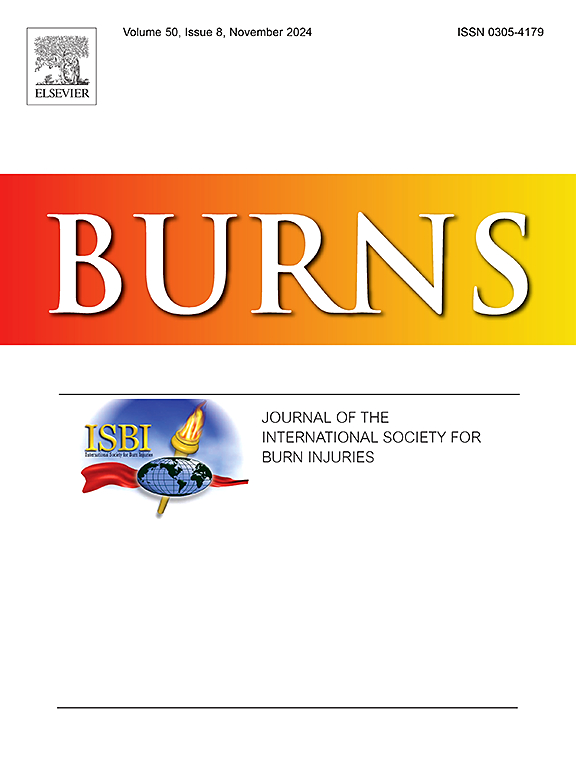Return to work in adults after burn injury in Australia: Western Australian outcomes, 2006–2024
IF 2.9
3区 医学
Q2 CRITICAL CARE MEDICINE
引用次数: 0
Abstract
Background
After a burn, return to work (RTW) is a key goal to restore social integration and quality of life. Burn survivors face multidimensional obstacles as they attempt to RTW, including physical limitations, mental health impacts, and social stigma. This study aimed to investigate the RTW rate over time and identify patient-reported factors associated with no return to work within 12 months of a burn in an Australian context.
Materials and methods
This retrospective population registry study included all eligible adult burn patients injured between 2006 – 2024 in Western Australia (WA). Outcomes included: Sickness Impact Profile (SIP, work scale) and Burn-Specific Health Scale-Brief (BSHS-B, work domain). Data analyses involved mixed-effects adjusted regression models analyzing RTW rate, work impairment, and BSHS-B work domain over time.
Results
A sample of 953 patients (16.5 % of WA burn population) were included in the study cohort, with 84.6 % of these engaged prior to their injury in work outside managing their home. Most were male (70 %), with median age 36 years (IQR: 26.0–50.0) and 84 % had surgery. The median %TBSA was 2.4 % (IQR: 0.8–6.7 %), 15 % (n = 138) of the sample suffering major (≥10 %) burns. Work-related injury was reported by 22 %. Significant predictors of reduced RTW within one year, included contact burn (p = 0.021); electrical injury (p = 0.012); male sex (p = 0.045); multiple admissions (p = 0.003); prolonged wound healing (p < 0.001); work-related injury (p = 0.008); and, more psychology sessions in the first month after burn (p < 0.001). By 6 weeks post-burn, 38 % had RTW, increasing to 92 % of the sample by 12 months. The mean time to return was 40 days (SD 50 days). At one month, 79 % reported work impairment (SIP), declining to 61 % at 6 weeks and 50 % at 12 months. Receiving more occupational therapy 1–3 months post burn was associated with reduced reported work impairment (p < 0.001).
Conclusion
While this study, which focussed on patient-reported outcome measures, confirmed that common, non-modifiable factors were barriers to return to work, timely multidisciplinary team input was shown to facilitate the high rate of return and early occupational therapy was associated with less reported work impairment, within one year after burn.
澳大利亚成人烧伤后重返工作岗位:2006-2024年西澳大利亚的结果。
背景:烧伤后,重返工作岗位(RTW)是恢复社会融合和生活质量的关键目标。烧伤幸存者在试图重返家园时面临多方面的障碍,包括身体限制、心理健康影响和社会污名。本研究旨在调查一段时间后的RTW率,并在澳大利亚的背景下确定患者报告的与烧伤后12个月内无法重返工作岗位相关的因素。材料和方法:本回顾性人口登记研究包括西澳大利亚州(WA) 2006 - 2024年间所有符合条件的成人烧伤患者。结果包括:疾病影响概况(SIP,工作范围)和烧伤特异性健康量表-简要(BSHS-B,工作领域)。数据分析涉及混合效应调整回归模型,分析随时间变化的RTW率、工作损害和BSHS-B工作域。结果:953例患者(16.5 %的西澳州烧伤人群)被纳入研究队列,其中84.6 %的患者在受伤前从事过家庭管理以外的工作。大多数是男性(70 %),中位年龄36岁(IQR: 26.0-50.0), 84 %做过手术。严重烧伤(≥10 %)患者TBSA中位数为2.4 % (IQR: 0.8 ~ 6.7 %),15 % (n = 138)。工伤报告为22% %。一年内RTW减少的显著预测因子包括接触烧伤(p = 0.021);电损伤(p = 0.012);男性(p = 0.045);多次录取(p = 0.003);结论:虽然这项研究的重点是患者报告的结果测量,证实了常见的、不可改变的因素是重返工作岗位的障碍,但及时的多学科团队投入表明,在烧伤后一年内,高复发率和早期职业治疗与较少报告的工作损伤有关。
本文章由计算机程序翻译,如有差异,请以英文原文为准。
求助全文
约1分钟内获得全文
求助全文
来源期刊

Burns
医学-皮肤病学
CiteScore
4.50
自引率
18.50%
发文量
304
审稿时长
72 days
期刊介绍:
Burns aims to foster the exchange of information among all engaged in preventing and treating the effects of burns. The journal focuses on clinical, scientific and social aspects of these injuries and covers the prevention of the injury, the epidemiology of such injuries and all aspects of treatment including development of new techniques and technologies and verification of existing ones. Regular features include clinical and scientific papers, state of the art reviews and descriptions of burn-care in practice.
Topics covered by Burns include: the effects of smoke on man and animals, their tissues and cells; the responses to and treatment of patients and animals with chemical injuries to the skin; the biological and clinical effects of cold injuries; surgical techniques which are, or may be relevant to the treatment of burned patients during the acute or reconstructive phase following injury; well controlled laboratory studies of the effectiveness of anti-microbial agents on infection and new materials on scarring and healing; inflammatory responses to injury, effectiveness of related agents and other compounds used to modify the physiological and cellular responses to the injury; experimental studies of burns and the outcome of burn wound healing; regenerative medicine concerning the skin.
 求助内容:
求助内容: 应助结果提醒方式:
应助结果提醒方式:


